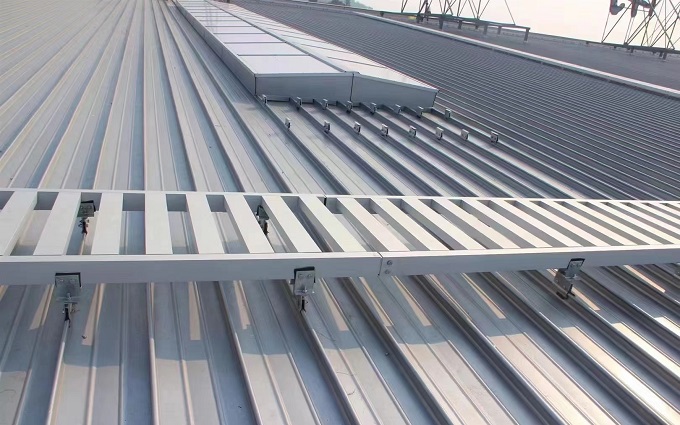Specifications for Roof Surface Exposed Galvanized Flat Steel Lightning Protection

1.Material Specifications:
Lightning arresters, down conductors, and grounding electrode materials must meet design specifications.
2.Down Conductors:
The specifications for the lightning rod down conductors are determined by design standards. The material must be galvanized steel. Underground connection lines should be no less than 40×4 mm galvanized flat steel. At the disconnection clamp, the down conductor should be directly connected or connected using two or more main rebars of the building, with a cross-sectional area greater than 100 square millimeters. The welding overlap length should be six times the diameter on both sides. Bends in the down conductor should not form sharp angles.
3.Connections:
Lightning down conductors must be interconnected with other metal parts on the building's roof, such as vent pipes and rainwater pipes.
4.Galvanization:
All metal parts of lightning protection devices must be galvanized with a uniform coating.
5.Grounding Connections:
The galvanized flat steel for lightning grounding and protective grounding must not form a "T" shape and should not be directly butt-welded. The welding overlap length must be twice the width of the flat steel (or six times the diameter for round steel) with no fewer than three weld edges. Welds on the two long edges should be flat and full, without undercut, slag inclusion, or weld spatter. Grinding with a grinding wheel is prohibited. Welding slag should be removed promptly, and two coats of anti-rust paint (two coats of asphalt paint for buried parts) should be applied.
6.Disconnection Clamp:
Use 40×4 mm and 25×4 mm galvanized flat steel for disconnection clamps with a lap length of 100 mm. The bolt hole distance from the edge should be 25 mm (drill hole diameter φ11 mm, galvanized bolts M10×25 mm), complete with galvanized washers and spring washers. The flat steel should be spot-welded on both sides of the steel pipe protection opening, and the pipe opening should be sealed. The height of the disconnection clamp should be consistent within a project, preferably 1.5-1.8 meters above ground, with added protection.
7.Using Main Rebars:
When using main rebars to bring the grounding system to the roof, it should be welded to the lightning belt using the same specification of galvanized flat steel. When using metal guardrails as lightning belts, they should be reliably welded to the main rebar and guardrails. The number and coordinates must match the design. At steel pipe connections, add flat steel cross-connection lines. If the grounding system uses foundation rebars without a grounding device, a disconnection clamp is not necessary, but there should be a "measurement point" for grounding resistance measurement. The measurement point should be 500 mm above ground if not specified in the design.
8.Grounding Device Depth:
The burial depth of grounding devices (grounding bodies and lines) must meet design or standard requirements. The grounding device must be inspected and accepted by the quality department and the construction unit before covering. The backfill soil should be free of stones and construction debris, and non-corrosive soil should be used. The soil should be compacted layer by layer during backfill.
9.Grounding Body Materials:
Typically use galvanized angle steel, steel pipes, or round steel. The diameter of round steel should be greater than 10 mm, the cross-section of flat steel should be greater than 100 square millimeters with a thickness of 4 mm, the angle steel thickness should be greater than 4 mm, and the steel pipe wall thickness should be greater than 3.5 mm. Material length is generally around 2.5 meters, with 50×50×5 mm angle steel.
10.Grounding Depth:
The depth of the grounding body's top should meet design requirements. If unspecified, it should be buried at least 0.6 meters deep. Independent lightning rods and their grounding devices should be more than 3 meters away from roads or building entrances.
11.Grounding Resistance:
The grounding resistance must meet design specifications.
12.Equipment Grounding:
Branch lines for grounding electrical equipment, appliances, and other detachable non-electrified metal parts must be directly connected to the grounding main line
RELATED NEWS
- Efficient Canopy Structures: Enhancing Gas Station Functionality and Aesthetics 2024-07-05
- Gas Station Construction Budget: How Much Does It Cost to Build a Gas Station? 2024-07-04
- Eight Key Factors in Aluminum-Magnesium-Manganese Roof Design 2024-07-04
- What Are Roof Purlins? What Are the Principles of Roof Purlin Layout? 2024-07-03
- Characteristics of Hangar Tents 2024-07-03
Categories
Latest News
Contact Us
Contact: Mr.Lu
Phone: +86-51668601029
E-mail: hbktech@163.com
Whatsapp:86+15152106218
Add: 1412, Building 2, Vanke Huaihai Xintiandi, Block 3, Quanshan District, Xuzhou City, Jiangsu Province
